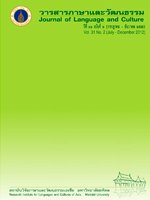The Mon language: Recipient and donor between Burmese and Thai
Main Article Content
Abstract
Mon is spoken in south Myanmar and parts of central and northern Thailand and has been in intense contact with its neighboring languages for many centuries. While Mon was the culturally and politically dominant language in the first millennium, its role was reduced to a local minority language first in Thailand, later in Myanmar. The different contact situations in which the Mon language has been used between Thailand and Myanmar has led to numerous instances of language change. The influence has not been one-way, with Mon on the receiving end only, but Mon was also the source of restructuring in Burmese and Thai. The present paper attempts to trace some of the contact induced changes in the three languages involved. It is not always clear which language was the source of shared vocabulary and constructions, but in many cases linguistic and historical facts can be adduced to find answers. While Mon language use in Thailand is diminishing fast and Mon in this country is undergoing restructuring according to Thai patterns, in Myanmar Mon is actually still exerting influence on Burmese, albeit mostly on a local level in varieties spoken in Mon and Karen States. The contact between genetically and typologically very different languages as is the case here leads in many cases to linguistically interesting outcomes.
Article Details
How to Cite
Jenny, M. (2014). The Mon language: Recipient and donor between Burmese and Thai. Journal of Language and Culture, 31(2), 5. retrieved from https://so03.tci-thaijo.org/index.php/JLC/article/view/20286
Section
Research Articles
The articles featured in the Journal of Language and Culture (JLC) constitute academic works representing the viewpoints of the respective author(s). It is crucial to note that these opinions do not necessarily reflect those of the Editorial Board.
All articles published in JLC are released under the Creative Commons Attribution 4.0 International License (CC BY 4.0). This license grants permission for unrestricted use, distribution, and reproduction in any medium, provided proper credit is given to the original author(s) and the source.


